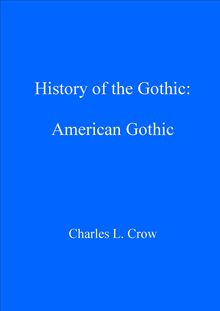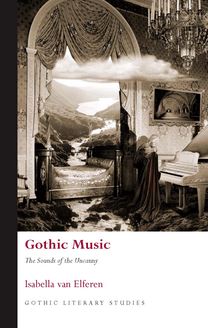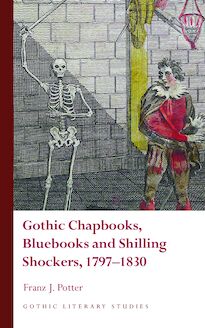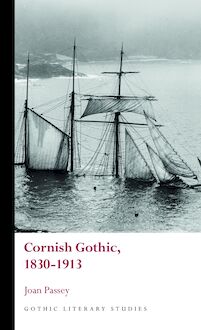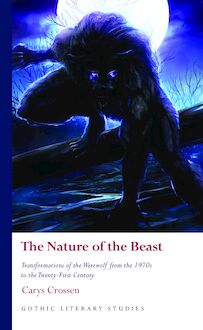Romantic Medicine and the Gothic Imagination , livre ebook
138
pages
English
Ebooks
2022
Vous pourrez modifier la taille du texte de cet ouvrage
Obtenez un accès à la bibliothèque pour le consulter en ligne En savoir plus
Découvre YouScribe et accède à tout notre catalogue !
Découvre YouScribe et accède à tout notre catalogue !
138
pages
English
Ebooks
2022
Vous pourrez modifier la taille du texte de cet ouvrage
Obtenez un accès à la bibliothèque pour le consulter en ligne En savoir plus
Publié par
Date de parution
01 avril 2022
Nombre de lectures
3
EAN13
9781786838506
Langue
English
This book debates a crossover between the Gothic and the medical imagination in the Romantic period. It explores the gore and uncertainty typical of medical experimentation, and expands the possibilities of medical theories in a speculative space by a focus on Gothic novels, short stories, poetry, drama and chapbooks. By comparing the Gothic’s collection of unsavoury tropes to morbid anatomy’s collection of diseased organs, the author argues that the Gothic’s prioritisation of fear and gore gives it access to nonnormative bodies, reallocating medical and narrative agency to bodies considered otherwise powerless. Each chapter pairs a trope with a critical medical debate, granting silenced bodies power over their own narratives: the reanimated corpse confronts fears about vitalism; the skeleton exposes fears about pain; the unreliable corpse feeds on fears of dissection; the devil redirects fears about disability; the dangerous narrative manipulates fears of contagion and vaccination.
Acknowledgements
Introduction: The Laboratory of the Gothic Imagination
Chapter 1: Reanimated Corpses, Blood, and the Gothic Vital Element
Chapter 2: Anaesthetic Skeletons and the Pain of Melancholy
Chapter 3: Counterfeit Corpses and Evaded Dissection
Chapter 4: The Devil and the Disability Narrative
Chapter 5: Contagious Narratives and Gothic Vaccination
Conclusion
Notes
Bibliography
Index
Publié par
Date de parution
01 avril 2022
EAN13
9781786838506
Langue
English
ROMANTIC MEDICINE AND THE GOTHIC IMAGINATION
SERIES PREFACE
Gothic Literary Studies is dedicated to publishing groundbreaking scholarship on Gothic in literature and film. The Gothic, which has been subjected to a variety of critical and theoretical approaches, is a form which plays an important role in our understanding of literary, intellectual and cultural histories. The series seeks to promote challenging and innovative approaches to Gothic which question any aspect of the Gothic tradition or perceived critical orthodoxy. Volumes in the series explore how issues such as gender, religion, nation and sexuality have shaped our view of the Gothic tradition. Both academically rigorous and informed by the latest developments in critical theory, the series provides an important focus for scholarly developments in Gothic studies, literary studies, cultural studies and critical theory. The series will be of interest to students of all levels and to scholars and teachers of the Gothic and literary and cultural histories.
SERIES EDITORS
Andrew Smith, University of Sheffield
Benjamin F. Fisher, University of Mississippi
EDITORIAL BOARD
Kent Ljungquist, Worcester Polytechnic Institute Massachusetts
Richard Fusco, St Joseph’s University, Philadelphia
David Punter, University of Bristol
Chris Baldick, University of London
Angela Wright, University of Sheffield
Jerrold E. Hogle, University of Arizona
For all titles in the Gothic Literary Studies series visit www.uwp.co.uk
© Laura R. Kremmel, 2022
All rights reserved. No part of this book may be reproduced in any material form (including photocopying or storing it in any medium by electronic means and whether or not transiently or incidentally to some other use of this publication) without the written permission of the copyright owner except in accordance with the provisions of the Copyright, Designs and Patents Act. Applications for the copyright owner’s written permission to reproduce any part of this publication should be addressed to the University of Wales Press, University Registry, King Edward VII Avenue, Cardiff CF10 3NS.
www.uwp.co.uk
British Library Cataloguing-in-Publication Data
A catalogue record for this book is available from the British Library.
EPUB ISBN 978-1-78683-850-6 EPDF ISBN 978-1-78683-849-0
The right of Laura R. Kremmel to be identified as author of this work has been asserted in accordance with sections 77 and 79 of the Copyright, Designs and Patents Act 1988.
The publisher has no responsibility for the persistence or accuracy of URLs for any external or third-party internet websites referred to in this book, and does not guarantee that any content on such websites is, or will remain, accurate or appropriate.
To Grandma Pat and Granddad Peters
C ONTENTS
Acknowledgements
Introduction: The Laboratory of the Gothic Imagination
1 Reanimated Corpses, Blood, and the Gothic Vital Element
2 Anaesthetic Skeletons and the Pain of Melancholy
3 Counterfeit Corpses and Evaded Dissection
4 The Devil and the Disability Narrative
5 Contagious Narratives and Gothic Vaccination
Conclusion
Notes
Bibliography
A CKNOWLEDGEMENTS
Though drafts of this book have been developed over many years, the final text was largely written during the 2020–1 COVID-19 pandemic. As such, it is tempting to view it as a product of isolation. Nothing could be further from the truth. My work has been inspired and guided by so many mentors and friends whose support from afar has been even more meaningful in these trying circumstances of quarantine and social distance.
I must start by expressing gratitude to my dissertation committee at Lehigh University, all of whom have continued to volunteer caring professional and personal support over the years. Their belief in the value of my work has been instrumental to the completion of this project. I hardly know how to begin to thank Beth Dolan for all her warm encouragement over the past fourteen years. She has been my consistent role model for careful scholarship and compassionate teaching. On top of the incredible work she does at Lehigh, she still has time to offer feedback, wisdom, and kind words. Similarly, a simple thank you to Dawn Keetley seems inadequate. She has been an eager mentor and source of inspiration for over a decade, and she continues to go out of her way to support and encourage me. Immense thank you also to Michael Kramp, whose enthusiastic confidence in my ideas and endeavours – especially the crazy ones – has been invaluable at all stages of the research and drafting process. The unfaltering support of these three mentors has given me strength time and time again. A special thank you to Dale Townshend, whose teaching was foundational for my development as a scholar of Gothic literature, and his involvement in the important early stages of this project was crucial. The training in Gothic Studies I received from Dale and Glennis Byron through the Gothic Imagination MLitt programme at the University of Stirling set me on my current path.
I have benefited from several academic communities. Many of the faculty, staff, and fellow students in the Lehigh English graduate programme have either read versions of this work or been subjected to excited conversations about it (willingly or unwillingly). Pete Nagy has frequently been the victim of such conversations. He has provided feedback on recent drafts and years of encouragement through eighties movie quotes. I think he understands how I think better than I do. Dashielle Horn, David Fine, and Kyle Brett have helped me maintain perspective and a sense of humour on countless occasions when I needed them most. I am also grateful to my many friends and mentors at Lehigh, especially but not limited to Wade Linebaugh, Abby Aldrich, Sara Monahan, Carol Laub, Anne Nierer, Jenna Lay, Suzanne Edwards, Scott Gordon, Kathleen Hutnik, and members of the Lehigh Gothic Reading Group, particularly Ashley Pfeiffer and Jimmy Hamill. I have and continue to benefit from the generous advice and camaraderie of the 18th/19th-Century Writing Group at Lehigh. Additional thanks to members of that group, Lyndon Dominique, Sarita Mizin, and Dana McClain.
I’d also like to thank my colleagues in the Department of Humanities and Social Sciences at South Dakota School of Mines and Technology, especially Haley Armstrong, Christy Tidwell, Kayla Pritchard, Carlie Herrick, and Allison Gilmore for their support and for putting up with conversations about things like exorcism and leeches at happy hour.
The community of the International Gothic Association – the IGA family – has been a cherished source of belonging, friendship, and pleasure, not to mention of scholarly inspiration. Most of the ideas in this book were presented over the years at its biennial conferences, where I benefited from a collective of brilliant friends: Enrique Ajuria Ibarra, Matt Foley, Neil McRobert, Chloé Germaine Buckley, Neal Kirk, Lorna Farnell, Gwyneth Peaty, Tuğçe Biçakçi Syed, Rebecca Duncan, Kate Gadsby-Mace, Daniel Kasper, and so many others. I am also thankful for my Romanticism friends and colleagues from the North American Society for the Study of Romanticism, especially Niffy Hargrave, Talia Vestri, and Emily Stanback, as well as members of the newly formed Disability Studies/Health Humanities writing group, who provided generous feedback on an early draft of the Introduction.
I became interested in the history of medicine when I started visiting medical museums. I discovered the Mütter Museum of the College of Physicians of Philadelphia in 2010 and returned as frequently as I could. Less frequent wanderings through the Hunterian Museum in London and Surgeons’ Hall in Edinburgh have been more directly influential on this book. My work has benefited from several Lehigh University funding sources, including the Strohl Graduate Summer Research Fellowship, the Lawrence Henry Gipson Institute Research Grant, the Lehigh College of Arts and Sciences Summer Research Fellowship, the Doctoral Travel Grant for Global Opportunities, and the Lehigh Humanities Center Faculty Seminar, which allowed me to do archival work at the National Library of Scotland, the Royal College of Physicians of Edinburgh Library, the British Library, Edinburgh University Special Collections, and the Wellcome Library.
A version of Chapter 4 was published in European Romantic Review in 2016, and I am grateful for permission from Taylor & Francis to include the current version with several overlapping sections. I’ll take this opportunity also to thank the late Diane Long Hoeveler for her encouragement of my work at that early stage. Thanks also to Sarah Lewis, Head of Commissioning at University of Wales Press, for her generous guidance and kind enthusiasm to see this project become a book.
Finally, I must express gratitude to members of my family who have, in equal measure, humoured and supported my academic pursuits. Friends Leah Van Tassel, Katie Ressel, and Lisa Belczyk have always been family and have always welcomed me ‘home’, no matter where they are or how far away I roam. Thanks to my Mom and Dad (who have wondered why I don’t study ‘nice things’), and Greg and Em for their support. This book is dedicated to my late grandparents, who would have been thrilled at its very existence.
Introduction
The Laboratory of the Gothic Imagination
Situations of torment, and images of naked horror, are easily conceived; and a writer in whose works they abound, deserves our gratitude almost equally with him who should drag us by way of sport through a military hospital, or force us to sit at the dissecting-table of a natural philosopher. 1
We begin with two anatomists: one an accomplished physician with a background in surgery, the other a fictional malcontent created by an author well aware of medical innovations. Both Matthew Baillie and Victor Frankenstein would have been at home at the dissecting table mentioned in

